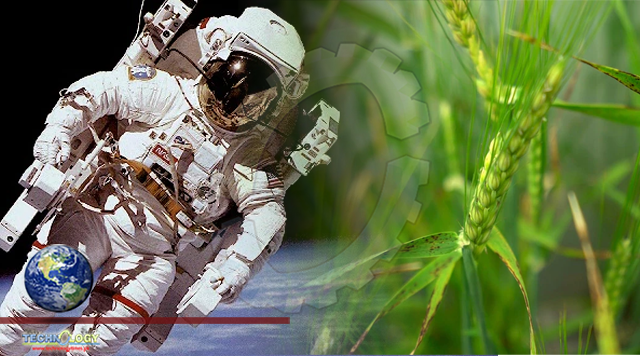Crops are being designed using genetic modification technology, where foreign DNA is introduced to a plant, changing its genetic makeup.

In a modest laboratory in Adelaide, a modest-looking box spins beneath an equally modest sign.
Key points:
- Scientists at the University of Adelaide are using genetic modification to design food for astronauts
- They hope the knowledge they gain will be applicable for farming on earth as well
- Public opinion is divided on genetically modified edible crops in Australia, even after moratoriums have been lifted
But the words “Plants For Space” suggest there’s nothing modest about the research taking place here.
The small box is actually an $80,000 microgravity machine, which could play a vital role in a mission to send people to Mars.
The University of Adelaide is using it to test crops it’s designing for space, to see how they perform when there’s less gravity.
“Plants obviously didn’t evolve to grow in space; it’s a somewhat foreign environment for them,” said plant scientist Matthew Gilliham, who is in charge of the research at Waite Institute.
“For instance, water becomes sticky and creepy in space.
“There’s no gravity draining the water from the soil and, in fact, it clings to surfaces and it can envelop plants completely.
“So one thing that we’re doing here with the microgravity experiments is trying to program the plant to cope with those environments.”
An essential part of the space race
Designing food for space was more the stuff of science fiction movies not so long ago.
But the race to send people to Mars is speeding up, with the US and China both landing rovers on the red planet in recent times.
“The amount of work that needs to be done to get plants ready for being that nutritional source for space is probably going to take at least 10 years, so we have to start now,” Professor Gilliham said.
Scientists in South Australia are working with researchers and space agencies in Australia and around the world to tackle the challenge.
Crops are being designed using genetic modification technology, where foreign DNA is introduced to a plant, changing its genetic makeup.
“People are starting to understand that science can really begin to solve these big, grand challenges,” Professor Gilliham said.
Public opinion divided
The level of acceptance of genetically modified (GM) crops, on earth at least, varies greatly across industries and among the public.
South Australia and New South Wales recently lifted long-standing moratoriums on GM crops, bringing them into line with the rest of the mainland states.
Tim Morcom, who farms near Bordertown in South Australia’s south-east, was one of the first in the state to sow GM canola.
“It was a great occasion, I thought, for South Australia to finally catch up with the other states,” he said.
Mr Morcom was keen to invest in herbicide-resistant GM canola to try and improve his weed control.
But it’s what’s in the pipeline that particularly excites the farmer.
“There’s just so much more breeding that plant breeders can breed into their crops,” he said.
“Frost is such a big issue.
“If we could get some frost tolerance into our crops, that would be worth billions.”
Scientists at the University of Adelaide are among those who have been working on just that for around two decades.
“We’ve got a lot of wheat and barley in here that’s been engineered for improved tolerance against frost, against drought and increased yield,” said associate professor Matt Tucker.
“It’s all been through its final stages of trialling, and essentially it’s ready for a commercial partner to come in.”
‘An easy sell for astronauts’
That’s where things become challenging, even with moratoriums no longer in place.
While GM oilseeds are farmed on a large scale in Australia, moving GM wheat, barley and other edible crops beyond the research phase is proving difficult.
The only country in the world to release GM wheat is Argentina.
“The biggest roadblock is still going to be the market,” Dr Tucker said.
“We can do a lot of trials in our glasshouses here, and we can do them in selected field sites, but it needs industry to say, ‘This is a technology that’s going to make a difference.'”
His colleague Professor Gilliham thinks genetically modified crops designed for space will come up against less resistance.
“I think it’s an easy sell for astronauts, surrounded by all that technology,” he said.
And he’s optimistic that by aiming for the stars, scientists could end up solving pressing issues back home.
“Space frees us up to really work on these technologies to make rapid gains and improve growth rate, reduce waste, improve nutrient use efficiency in ways that we haven’t been able to do here on earth, but then bring these solutions back,” he said.
Originally published at Abc news